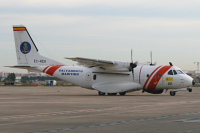|
One of the major’s commercial successes of
the Spanish division of EADS is the Fully Integrated Tactical System (FITS)
for marine patrol. Basically, the FITS, is the heart of a tactical
system of monitoring mission and marine security, with the capacity to
integrate and to control multiple mission sensors. The system has the
capacity to interact with the navigation equipment of the airplane and
display in real time the tactical situation to the operators of the
sensors that integrated by the FITS.
This system has property of being easy and quickly adaptable to the
observation needs and monitoring that the user requires, in addition, it
can be mounted in a wide range of platforms: CASA C-212, CN-235 and
C-295, the Lockheed P-3 Orion or the Airbus A319 CJ. The keys are the
open architecture computers, modular design and the standard interfaces.
All these designed to allow update and reusability of components, during
the whole system life. This allows the adaptation of different sensor
configurations, based on the final use that the customer wants to assign
to the platform. All the operators consoles are multifunction and can be
configured during the flight, which allows the operators to use any
particular system indifferently.
The addition of a greater number of systems for observation and
monitoring, results in a greater work load for the operators. The design
of the FITS solves this situation without problems, allowing to create
more system operators positions, according to the volume of information
increases and needs to be processed. The standard for an airplane like
P-3 Orion is to be equipped with 6 consoles or more, a C-295 ASW can be
need four positions, 2 for the CN-235 in coastal guard functions and
just one console for a C-212 configured for marine patrol.
Today the users of system FITS are numerous. The main customer is the
U.S. Coast Guard (USCG), that placed an order for 36 HC-144A Ocean
Sentry (denomination given by the USCG to the CN-235-300M). The
aircrafts was purchased within the " Deep Water" program. The Ocean
Sentry defers a little the rest from CN-235/C-295 equipped with FITS,
since the HC-144A has the possibility of disassembling consoles in the
cargo bay, and even so to be able to continue operating those sensors
from cockpit. This allows releasing the fuselage centre section for any
other use, although to operate in this way generates a great work load
to the flight crew.
Spain is another one of the main operators for this system. Two CN-235-100
MPA are flown by the Guardia Civil (Civil Guard, police and security
corps) and another three CN-235-300 MPA by “Salvamento Maritimo” (Marine
Rescue, a government agency). In both cases the configuration of
equipment is very similar although it is not identical. Meanwhile the
“Ejercito del Aire” (Spanish Air Force) uses the system in its five P-3M
Orion, and in six CN-235-100 reconfigured to MPA version in order to be
flown for SAR duties.
Other European operators are the Irish Air Corps that recently owns two
modernized CN-235-100 with FITS, and Portugal is waiting deliveries for
five C-295 configured of marine patrol and sea monitoring.
|
The
T.19B-22 interiors |
|
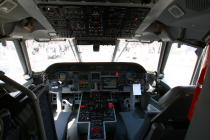 |
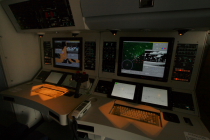 |
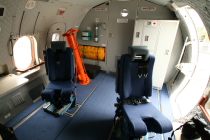 |
|
Cockpit
with integrated FITS display sreen. |
Systems operators positions. |
Markers launcher and
observers seats. |
|
In Latin America, the main user until now
is Mexico, that flies eight C-212. Originally acquired like military
transport, later were transformed to maritime patrol aircrafts equipped
with the FITS. The Mexican Navy studies the purchase of additional units,
since the good and secured operative results up to date.
Brazil contracted with EADS CASA the modernization for eight P-3A to the
new standard P-3BR. The agreement also includes a mission support
centre, and a tactical trainer for crews. These aircrafts will have a
FITS with six positions for mission system operators.
On the other hand, the Navy of Chile will be the next customer in the
region, since under the program " Alcatraz", brand new C-295 Persuader
with MPA/ASW capacity glides to gradually replace all airplanes of
marine patrol with the initial acquisition of 3. The contract also
includes an option by another five C-295 additional, of with three units
that will become firmly orders in the third quarter of 2009. A total
eight C-295 were included in the program, and Chilean navy anticipates
to use four units, equipped with a MAD and the possibility of being
armed with AGM-84 Harpoon missiles and antisubmarine torpedoes. The
other three C-295 will be marine patrol aircrafts exclusively. The last
and eighth unit will be an standard freighter.
A customer: Salvamento Marítimo
Delivered during the second semester of
2007, brand new CASA CN-235-300 MPA acquired by the Ministry of Public
Works and the Economy for its agency State Society of Rescue and Marine
Security (marine Security or “Salvamento Maritimo”) entered in service.
These units are destined to give cover to the Spanish Mediterranean
coast, the Cantabrian cornice and the Canary Islands, thus including all
the marine area of responsibility of the Spanish kingdom. The present
fleet is made up of three CN-235-300 MPA of new construction: the EC-KEK/101
“Isabel de Villena” (c/n 166, ex- EC-235), the EC-KEL/102 “Rosalía de
Castro” (c/n169, ex- EC-027) and the EC-KEM/103 “Josefina of the Tower”
(c/n 171, ex- EC-021). All of them were bought by the Marine Rescue,
agency that only had four Beechcraft airships B55 Baron rented to the
state company Senasa, that used for marine contingencies
|
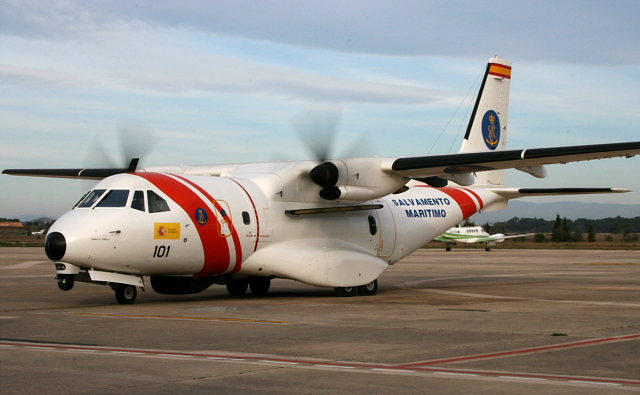 |
|
The Salvamento Maritimo
aircraft warms up engines in the Technical Block
platform of the Manises Airport, Valencia, before a
routine flight over Mediterranean waters. |
|
New CN-235-300 MPA in marine patrol mission
can fly more than nine hours, a reason why they have capacity to take
part in operations with a reach of 3,706 kilometers, or an operational
range of 1,853 kilometers, flying at a speed of 243 knots (437 Km/h) and
being able to reach a peak altitude of 30,000 ft. The crew is made up of
three people in charge to pilot the airplane, besides two technicians
specialized in the operation of the equipment for location, tracking and
the integrated systems of sea monitoring. The crew of the airplane not
only maintains contact and coordination with the land centres, but also
with all the units that participate in a given rescue operation, in
order to obtain the maximum efficiency in the habitual rescue
interventions of shipwrecks or protection to the environment.
Aircraft interior is separated in three parts. Behind the flight cabin,
there are a rest area with four seats and two closets with electronic
equipment. In the following section, separated by a bulkhead, are the
two consoles for the FITS operators. One second separation shows the
most versatile zone, where the rescue equipment, buoys and markers are
sotred, besides two observers positions. This third sector can quickly
be reconverted to load cabin, which gives to the aircraft greater
flexibility maintaining its operational capacities. A common use of
cargo bay is to accommodate a deposit with an oil dispersing agent,
along with the associated dosing equipment, allowing in-flight
dispersion through the open back cargo door.
In order to develop their mission, these airplanes are especially
equipped with already mentioned FITS. These aircrafts have a gyro
stabilized turret Star Saphire II underneath the nose, that contains an
infrared sensor, a diurnal color TV camera with continuous zoom lens and
another Spotter Scope TV camera with fixed optics, for long range
diurnal observation. Also they have a Telephonics APS-143C (V) maritime
surveillance radar mounted under the front fuselage, with a maximum
range of 200 nautical miles. The Terma Side Looking Airborne Radar (SLAR),
mounted in the fuselage right under the wings roots, is used for
hydrocarbon leaks detection at sea. It allows to cover great surfaces in
any meteorological conditions, detecting small and great zones of
contamination that later are analyzed in detail by other sensors. The
subsystem of contamination monitoring uses the mentioned SLAR; in
addition to an ultraviolet / infrared scanner that allows to study the
surface of the spill or contaminated area. A microwaves hydrocarbon and
a laser sensor allow to the detection and a detailed analysis of the
extension and thickness like other characteristics of the spills,
allowing the detection of contamination under the marine surface too.
All of this, in any meteorological situation and still at night.
|
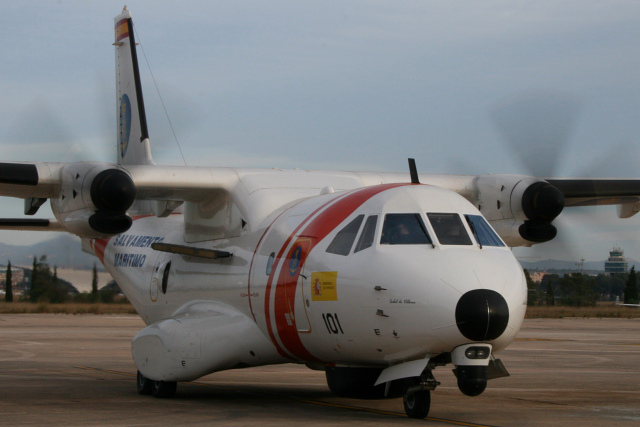 |
|
Frontal view with the
FLIR/EO turret, the radar APS-143C (V) 3 fairing,
the under wing SLAR, and bubble window for
observation. |
|
In the FITS are integrated mission sensors,
navigation equipment and communications. The system presents/displays
tactical intelligence and of navigation in real time to the operators,
being able to transmit the information collected to other aircrafts,
ships or ground stations. Also it includes a digital camera that merge
GPS and of mission data, and digital engraving of audio video. The ships
Automatic Identification System ( AIS) of CN-235-300 MPA allows the
detection and identification of boats in a quickly and effective way.
The AIS is a complementary system of aid mandatory for ships bigger than
300 tons, and they must use a AIS Class A. This is an emission system
that uses the same maritime VHF radio frequency to send and receive
ships information like name of the ship, indicative of call, OMI
identification number, UTC date and hour, position in datum WGS84,
course COG, speed SOG, port of destiny, ETA, type of ship, length and
load, GPS, angle of rudder, etc. The recreational and sports boats can
use a AIS Class B (with less functionalities than the class A), and see
all the information of navigation in the zone. As well, the sport boats
also can issue their own data. Therefore this complementary system to
the radar offers to a greater information of the marine traffic of the
area where this sailing itself, providing a greater security. In this
eventuality that some ship was remote of the coast in an emergency
situation, the aircraft can directly support the crew within a minimum
reaction time. The plane is equipped with markers, life rafts or diverse
emergency equipment that can be launched from the after cabin or the
cargo door.
The system capacity is clear, being a fundamental tool for the tasks
that Marine Rescue carry out, not only in the Spanish coasts, but also
in support of third parties countries of the region (especially to those
of the African Atlantic coast).
The aerial fleet of Marine Rescue is composed by nine helicopters units,
three brand new Agusta-Westland AW139 recently delivered, three Sikorsky
S-61N, two Eurocopter AS-365N2 and one Bell B-212. Four Beech B-55
continue operating along the three mentioned CN-235. The delivery of a
fourth CN-235 of the same characteristics is pending, ant it will serve
as support just in case that someone of the remaining aircrafts is not
serviceable or when the operative requirements ask for a unit to the
cover some specific service.
Zaragoza, June 25 2009
|
